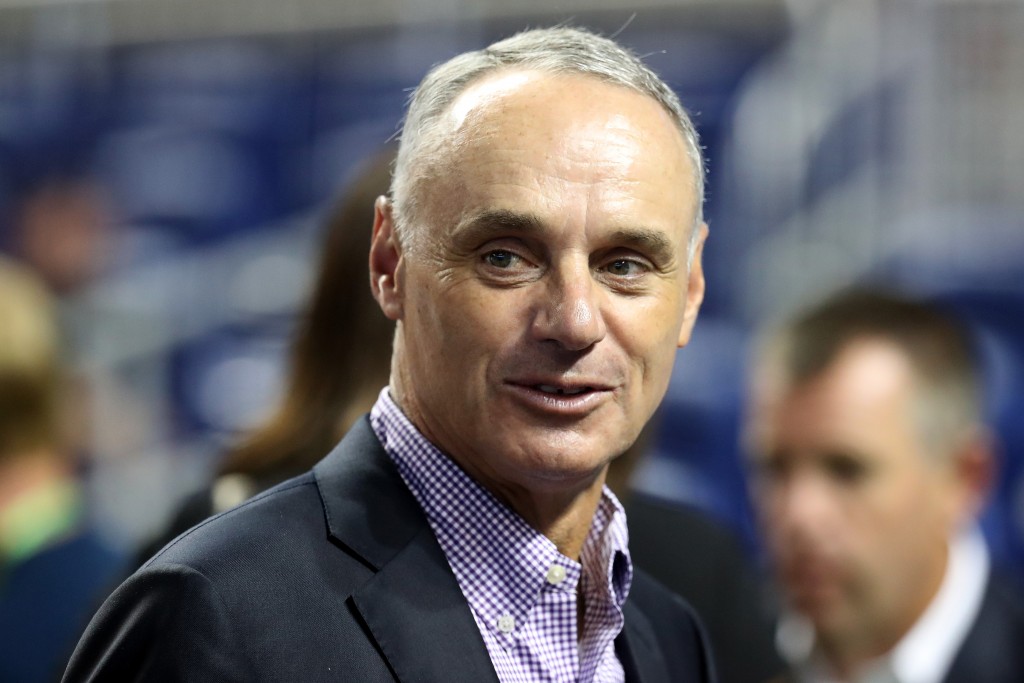
In a wide-ranging piece, Don Van Natta Jr. of ESPN chats with MLB commissioner Rob Manfred about possible changes to the sport that could be implemented over the coming years. Of particular note are Manfred’s comments on a trio of issues: an automated strike zone, pitch clocks and the possibility of league expansion.
Manfred expressed support for the implementation of the robotic strike zone at the major league level in 2024. Precisely what form that’d take isn’t clear, as the commissioner raised two possibilities for such a setup. The first would be to have all ball-strike calls computer-generated, with the result relayed to the human umpire via earpiece. An alternative possibility is to leave the home plate umpire in charge of initial calls but institute some form of challenge system, whereby each manager would have a finite number of chances to contest a ball-strike call during the game.
MLB has tested the automatic strike zone in the Triple-A Pacific Coast League for the past five weeks. The possibility of taking calls away from human umpires has been discussed for some time, with the proliferation of pitch-tracking technology making that a more viable possibility. The process hasn’t always gone entirely smoothly, however. Last month, Guardians manager Terry Francona opined to The Athletic that an automated zone used in exhibition play in 2020 was “not ready.” Francona suggested that while the zone tended to be precise on the corners of the plate, “up and down it’s got some work to do.”
In addition to having every pitch called by the robotic zone, MLB has experimented with the challenge system during certain minor league games. Two weeks ago, Manfred told reporters (including Evan Drellich of the Athletic) that the league was likely to continue both systems in the minors and didn’t intend to institute the automated zone next season. “We’re continuing to experiment in the minor leagues,” Manfred said at the time. “Big kind of development in the challenge-system alternative. The idea of using two different formats is a big change this year.”
While the automated strike zone seems unlikely to be a factor at the major league level before 2024, the pitch clock seems to be trending towards implementation next season. MLB has been testing with as few as 14 seconds between offerings when no runners are on base at certain levels of the minors. Van Natta writes that the 14-second marker would also be a target for major league implementation, while pitchers would have 18 or 19 seconds to throw when runners are on base. Manfred’s affinity for the pitch clock as a means of expediting pace of play is hardly a new development. He’s supported its testing in the minor leagues, and he expressed a desire last November for it to be part of the most recent round of CBA negotiations.
On-field rules changes ended up on the back burner as the league and Players Association focused on bigger core economics issues late in CBA talks. Yet the sides did agree to the implementation of a rules committee that’ll go into effect in 2023. The committee will be made up of four active players, six league appointees and an umpire. The league’s majority gives it de facto authority to implement many on-field rules changes it desires, and the committee will have the right to institute a new rule within 45 days of informing the MLBPA. (Under the previous CBA, the league had to wait one year after informing the PA before making a unilateral on-field rules adjustment).
This week, Andy Martino of SNY reported the identities of the people expected to be on the 2023 committee. Making up the players’ contingent are Jack Flaherty, Whit Merrifield, Austin Slater and Tyler Glasnow, with Ian Happ and Walker Buehler tabbed as alternates. On the league side will be John Stanton (Mariners), Bill DeWitt (Cardinals), Greg Johnson (Giants), Dick Monfort (Rockies), Tom Werner (Red Sox) and Mark Shapiro (Blue Jays). Bill Miller is expected to serve as the umpire representative. Along with the pitch clock, the committee is widely expected to examine the possibility of enlarging the bases and limiting defensive shifting.
While on-field rules changes figure to be relatively simple to implement, league expansion would be a much more complex process. Manfred tells Van Natta he’d “love to get to 32 teams,” although he didn’t elaborate a timetable or possible target cities for two new franchises. MLB’s last round of expansion was in 1998, when the Diamondbacks and Devil Rays were added to push the league from 28 to 30. Each of the NFL (2002), NBA (2004) and NHL (2021) have added teams to their respective leagues within the past two decades.
Manfred himself is under contract through 2024, having been unanimously approved for an extension by the league’s owners in November 2018. Van Natta reports the commissioner has a $17.5MM annual base salary under that deal, which also includes unspecified performance bonuses. Asked whether he wanted to continue in the role beyond 2024, the 63-year-old Manfred said he “hasn’t made a decision about what I’m going to do, whether I want to continue. I love the job, but I haven’t really made a decision about what’s next.“
Credit : Source link






